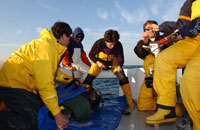 The disappearing populations of bluefin tuna were once so plentiful in the North Sea that their carcasses filled fish-auction houses. In a fascinating look at bluefin tuna, past and present, the Census of Marine Life, a TGF partner, highlights research from several of its affiliated scientists. In research affiliated with COML’s History of Marine Animal Populations, Brian R. MacKenzie of the Technical University of Denmark and the late Ransom Myers of Canada’s Dalhousie University have painted the first detailed portrait of a burst of fishing from 1900 to 1950 that preceded the collapse of once abundant bluefin tuna populations off the coast of northern Europe. The booming catches helped strip the Atlantic bluefin population in a relative blink of time – 1910 to 1950. The species virtually disappeared from the North Sea in the early 1960s and is still rare today. (In the photo above, a couple of hundred tuna are laid out for an auction in Skagen, Denmark. Photo by H. Blegvad, c.1946.)
The disappearing populations of bluefin tuna were once so plentiful in the North Sea that their carcasses filled fish-auction houses. In a fascinating look at bluefin tuna, past and present, the Census of Marine Life, a TGF partner, highlights research from several of its affiliated scientists. In research affiliated with COML’s History of Marine Animal Populations, Brian R. MacKenzie of the Technical University of Denmark and the late Ransom Myers of Canada’s Dalhousie University have painted the first detailed portrait of a burst of fishing from 1900 to 1950 that preceded the collapse of once abundant bluefin tuna populations off the coast of northern Europe. The booming catches helped strip the Atlantic bluefin population in a relative blink of time – 1910 to 1950. The species virtually disappeared from the North Sea in the early 1960s and is still rare today. (In the photo above, a couple of hundred tuna are laid out for an auction in Skagen, Denmark. Photo by H. Blegvad, c.1946.)The chronicle of decimation of the bluefin tuna population in the North Sea is being published as other COML researchers -- including TGF scientists Andre Boustany, Steven Teo and Barbara Block -- are discussing the latest results of Tag-A-Giant. Fish tagged off Ireland and in the Gulf of Mexico are revealing remarkable migrations and life-cycle secrets of the declining species. For example, two fish tagged within minutes of each other off western Ireland wound up more than 3,000 miles (5,000 kilometers) apart eight months later. One traveled 3,600 miles (6,000 kilometers) southwest in 177 days past Bermuda to waters about 180 miles (300 kilometres) northeast of Cuba. The other remained in the eastern Atlantic and moved off the coasts of Portugal. A third tagged bluefin swam into the Mediterranean Sea and was caught by fishers southeast of Malta in 2005.
We believe there are two stocks of Atlantic bluefin tuna, one that spawns in the Mediterranean Sea, the other in the Gulf of Mexico and the Florida Straits. We theorize that the two stocks forage together in the North Atlantic and travel to opposite sides of the ocean to reproduce. As Ron O'Dor, another COML researcher, said: "Part of the lesson here is that restoring bluefin tuna populations to health requires us to consider and manage activities one-fifth of the way around the world.”
We're getting a lot of interest in what's happening to bluefin tuna. Science Daily, BBC News, Reuters, and more than 40 other online news publications around the world are featuring this story.




No comments:
Post a Comment